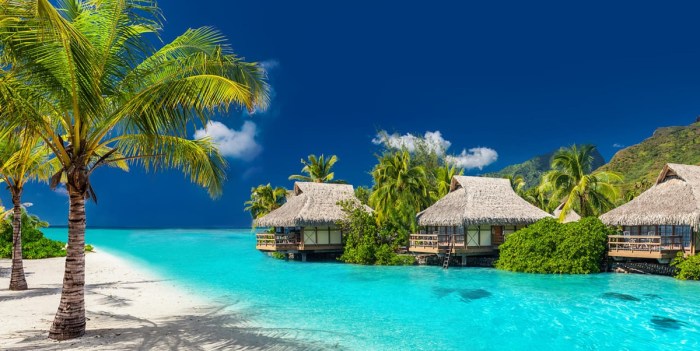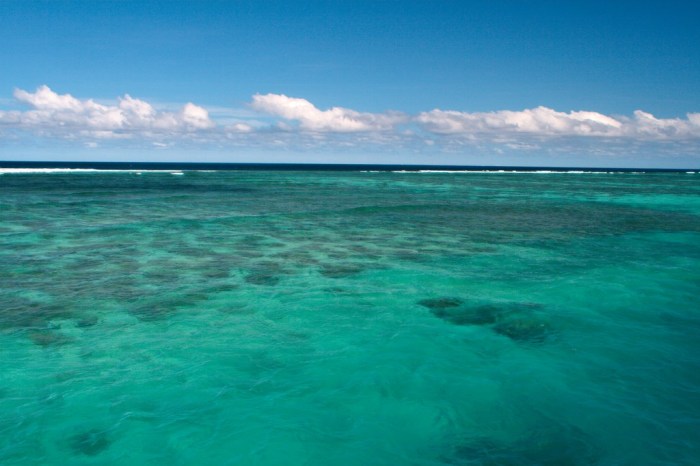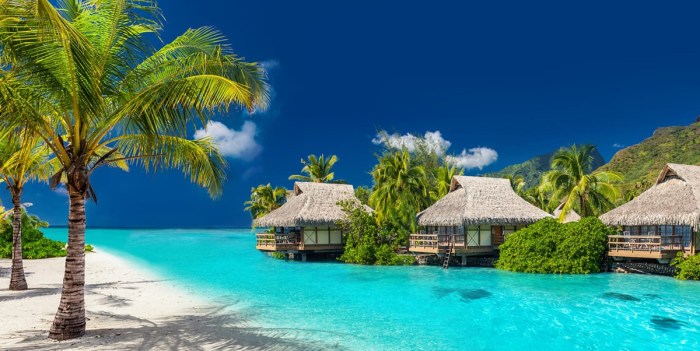Best time to visit Fiji? That’s a question many dreamers ask themselves. Fiji’s tropical beauty, sparkling waters, and vibrant culture beckon visitors year-round, but the best time depends heavily on what you want to do. From surfing the waves to exploring ancient traditions, this guide dives deep into the perfect time for every adventurer, whether you’re chasing the ultimate snorkeling experience or seeking a cultural immersion.
Discover when the crowds thin, the prices drop, and the weather is at its best.
This comprehensive guide will explore Fiji’s climate, highlighting seasonal variations across different islands. We’ll also analyze the best time for specific activities like surfing, diving, and hiking. Understanding the tourist volume, pricing fluctuations, and cultural events will help you plan the perfect trip. We’ll compare popular destinations and offer illustrative examples to paint a vivid picture of what to expect during different times of the year.
Overview of Fiji’s Climate
Fiji’s tropical climate, influenced by the South Pacific Ocean, offers a diverse range of weather patterns throughout the year. Understanding these patterns is crucial for planning your Fijian adventure and ensuring you’re prepared for the conditions you’ll encounter. The variations in temperature and rainfall across different islands, coupled with prevailing wind patterns, create a unique experience for visitors.The islands of Fiji experience a warm, humid climate year-round, with consistent sunshine and moderate temperatures.
However, there are distinct wet and dry seasons, along with regional differences that affect the experience of each island. This makes it essential to consider the time of year when you plan your visit to ensure you’re prepared for the conditions.
Fiji’s Climate Patterns Throughout the Year
Fiji’s climate is generally warm and humid, but there are notable seasonal variations in rainfall and sunshine hours. The wet season, characterized by higher rainfall, typically occurs from November to April, while the dry season, with less rainfall and more sunshine, usually runs from May to October. These patterns are not uniform across all islands, though.
Typical Weather Conditions for Different Months
The weather in Fiji varies depending on the month. November to April is generally the wet season, with higher rainfall and potential for thunderstorms. May to October is the dry season, with more sunshine and lower rainfall. This variation is crucial for selecting the best time to visit.
Variations in Temperature and Rainfall Across Different Islands
While Fiji’s overall climate is tropical, variations in temperature and rainfall exist between islands. Generally, the northern islands experience slightly warmer temperatures and more rainfall, particularly during the wet season. The southern islands often experience slightly cooler temperatures and less rainfall. The precise differences can vary from year to year, but these general trends hold true.
Typical Wind Patterns and Their Influence on the Weather
The trade winds, blowing from the east, significantly influence Fiji’s weather. These winds play a critical role in determining the amount of rainfall and the intensity of storms. The prevailing wind patterns generally bring rain to the windward sides of the islands, and the leeward sides experience more sunshine. This understanding of wind patterns is helpful in anticipating potential weather changes.
Average Temperatures and Rainfall for Key Islands
| Month | Average Temperature (°C)
|
Average Rainfall (mm)
|
Average Temperature (°C)
|
Average Rainfall (mm)
|
|---|---|---|---|---|
| January | 28 | 250 | 29 | 150 |
| April | 28 | 200 | 29 | 100 |
| July | 27 | 100 | 28 | 50 |
| October | 27 | 150 | 28 | 75 |
Frequency of Sunshine Hours in Various Months
| Month | Average Sunshine Hours – Viti Levu | Average Sunshine Hours – Yasawa Islands | Average Sunshine Hours – Lau Group |
|---|---|---|---|
| January | 6 | 7 | 8 |
| April | 8 | 9 | 10 |
| July | 10 | 11 | 12 |
| October | 7 | 8 | 9 |
Best Time for Specific Activities
Fiji’s diverse climate offers opportunities for various activities throughout the year. Understanding the best time to visit for specific interests can significantly enhance your Fijian adventure. Choosing the right season can ensure optimal conditions for activities like surfing, snorkeling, or hiking, while avoiding potentially disruptive weather patterns.
Best Time for Surfing
Fiji’s consistent swells make it a world-renowned surfing destination. The best time to experience the thrill of surfing in Fiji is generally during the months of April to October. This period coincides with the south-east trade winds, which often produce powerful waves perfect for experienced surfers. While other months may offer smaller waves, this period is known for its reliability and consistently high wave quality.
Best Months for Snorkeling and Diving
Snorkeling and diving in Fiji’s vibrant coral reefs are best enjoyed during the dry season, typically from May to October. During these months, the water is generally clearer, visibility is excellent, and the marine life is more active. The reduced rainfall and calmer seas create ideal conditions for underwater exploration. You’ll witness a diverse array of colorful fish, coral formations, and perhaps even marine mammals.
Optimal Time for Experiencing Fijian Culture and Traditions
Fiji’s vibrant culture is best appreciated throughout the year, although the dry season, from May to October, is generally preferred. During this period, cultural events and festivals are often held, providing an immersive experience of Fijian traditions. Visiting during the wet season, while possible, may sometimes result in fewer cultural activities and events.
Fiji’s gorgeous beaches are best enjoyed during the dry season, typically from May to October. If you’re considering a remote work trip to Fiji, and looking for some extra perks, check out the Natchez remote worker incentive program natchez remote worker incentive program – it might just sweeten the deal for your tropical getaway! The ideal weather for swimming and exploring the islands is there during these months.
Suitability of Different Seasons for Hiking and Exploring National Parks
Hiking and exploring Fiji’s national parks are generally suitable year-round. However, the dry season (May to October) offers the most favorable conditions. During this time, the trails are generally drier, the weather is more predictable, and the visibility is better. The wet season, although presenting some challenges, also provides unique opportunities to experience the lush, verdant landscapes of the islands.
Best Time to Avoid Cyclones or Heavy Rainfall
The wet season, generally from November to April, is when Fiji experiences its highest rainfall and potential for cyclones. Planning your trip outside this period minimizes the risk of encountering heavy rain, flooding, or severe weather conditions. It is crucial to research the specific forecast before your trip. Fiji’s weather can vary greatly, and staying informed about potential weather patterns is essential for a safe and enjoyable experience.
Comparison of Best Months for Various Activities
| Activity | Best Months | Conditions |
|---|---|---|
| Surfing | April – October | Strong south-east trade winds, powerful waves |
| Snorkeling/Diving | May – October | Clear water, excellent visibility, active marine life |
| Hiking/National Parks | May – October | Dry trails, predictable weather, good visibility |
Crowds and Prices
Fiji’s beauty attracts visitors year-round, but the volume of tourists and associated costs fluctuate significantly depending on the time of year. Understanding these patterns is crucial for planning a trip that balances enjoyment with affordability and manageable crowds. Knowing the ebb and flow of the tourist season can help you make informed decisions about when to visit.The price of travel, including flights and accommodation, tends to correlate with tourist volume.
Peak season, typically during the dry season, sees increased demand, which often translates to higher costs. Conversely, the off-season presents opportunities for more budget-friendly travel and fewer crowds, allowing for a more relaxed and personalized experience.
Tourist Volume Throughout the Year
Fiji experiences varying levels of tourist activity throughout the year. The peak season generally aligns with the dry season, offering warm weather and sunny skies ideal for outdoor activities. This period, typically from November to April, attracts a large number of visitors, leading to increased prices and potentially more crowded attractions. Conversely, the wet season (May to October) sees a reduction in tourist numbers, offering a more tranquil and less crowded experience.
Cost of Flights and Accommodation
The cost of flights and accommodation fluctuates significantly depending on the time of year. Flights to Fiji during peak season (November-April) tend to be more expensive, while off-season (May-October) flights are often more affordable. Similarly, hotel rates reflect this seasonal pattern, with higher costs during the peak season due to increased demand.
Average Prices for Tours and Activities
Tour and activity prices also vary based on the time of year. Popular excursions, like island hopping or scuba diving, typically cost more during peak season when demand is higher. The off-season offers a chance to experience these activities at potentially lower prices.
Impact of Crowds on Experiences
The presence of large crowds can significantly impact the overall experience of visiting Fiji. During peak season, popular attractions and beaches can become crowded, potentially detracting from the tranquility and exclusivity that many visitors seek. Conversely, visiting during the off-season can lead to a more intimate and personal experience, allowing you to fully immerse yourself in the beauty and culture of Fiji.
Fiji’s stunning beaches and turquoise waters are best enjoyed during the dry season, typically from May to October. Considering travel, though, it’s crucial to be prepared for any potential disruptions. Checking out us airports pandemic travel tips will help you navigate any potential airport procedures and restrictions. So, if you’re planning a trip to paradise, keep an eye on these factors to ensure a smooth journey and unforgettable Fijian vacation!
Accommodation Availability
Accommodation availability varies depending on the season. During peak season, popular hotels and resorts can fill up quickly, and finding last-minute availability can be challenging. In contrast, the off-season typically offers a wider range of options and greater flexibility in terms of booking.
Average Prices (Illustrative Table)
| Month | Average Flight Price (USD) | Average Hotel Price (USD/night) | Average Tour Price (USD) |
|---|---|---|---|
| November | 800 | 250 | 150 |
| December | 850 | 280 | 160 |
| January | 900 | 300 | 170 |
| February | 880 | 270 | 165 |
| March | 850 | 250 | 155 |
| April | 820 | 230 | 145 |
| May | 750 | 200 | 130 |
| June | 700 | 180 | 120 |
| July | 680 | 170 | 115 |
| August | 700 | 180 | 120 |
| September | 720 | 190 | 125 |
| October | 750 | 200 | 130 |
Note: These are illustrative averages and actual prices may vary based on specific dates, airline, hotel, and tour choices.
Festivals and Events
Fiji’s vibrant culture comes alive through its numerous festivals and events, offering visitors a unique opportunity to immerse themselves in the island nation’s traditions. These celebrations showcase the rich history, artistry, and hospitality of the Fijian people, providing a captivating backdrop to any vacation. Experiencing these events is a significant part of understanding Fiji’s soul.The best time to experience these festivals and events is typically during the dry season, from April to October.
This period offers pleasant weather, ideal for outdoor activities and celebrations. Furthermore, many festivals are scheduled during this period, allowing tourists to participate in multiple cultural experiences throughout their trip.
Significant Cultural Festivals
Fiji boasts a diverse range of festivals, each with its own unique characteristics and significance. These celebrations often intertwine with the nation’s rich history, traditions, and cultural expressions. They offer a glimpse into the heart of Fijian society.
- Festival of the Arts: This event is a showcase of Fijian artistry, highlighting traditional crafts, music, and dance. It’s a vibrant display of talent and creativity, bringing the community together. This festival typically takes place in various locations across Fiji, with the main event often held during the dry season.
- Lovo: This is a traditional Fijian feast, where food is cooked underground in a large pit. The Lovo is a significant cultural event, often held during special occasions like weddings, and is an excellent opportunity to sample authentic Fijian cuisine. It’s frequently held throughout the year, depending on the specific community and event.
- Meke Competitions: Meke are traditional Fijian dances, and competitions showcasing these dances are common. These events often involve elaborate costumes, rhythmic movements, and powerful expressions of Fijian culture. Meke competitions can be found throughout the year, often tied to village events and celebrations.
- National Day Celebrations: Fiji’s Independence Day, celebrated on October 10th, is a national holiday with festivities across the country. The celebrations involve parades, cultural performances, and community gatherings. This specific date is a fixed point on the calendar.
Best Time to Experience These Events
The best time to experience these festivals and events is during the dry season, from April to October. This period offers consistently pleasant weather, allowing for outdoor celebrations and comfortable participation. This is a crucial factor in determining the ideal time to visit Fiji and experience these events.
Impact on Visitor Experience
Experiencing Fiji’s festivals profoundly enhances the visitor experience. They provide opportunities to engage directly with the local culture, learn about Fijian traditions, and witness the warmth and hospitality of the Fijian people. These events also contribute to the overall ambiance and atmosphere of Fiji, enriching the tourist experience beyond the typical beach vacation.
Important Cultural Events and Corresponding Months
- Festival of the Arts: Typically held during the dry season (April-October)
- Lovo: Occurs throughout the year, tied to specific events and communities.
- Meke Competitions: Held throughout the year, often coinciding with village events.
- National Day Celebrations: Celebrated on October 10th.
Major Festivals and Events
| Festival/Event | Dates | Location |
|---|---|---|
| Festival of the Arts | Variable, typically dry season | Various locations across Fiji |
| Lovo | Throughout the year | Various villages and communities |
| Meke Competitions | Throughout the year | Various villages and communities |
| National Day Celebrations | October 10th | Nationwide |
Illustrative Examples of Weather Conditions

Fiji’s diverse landscapes and climate are best appreciated through vivid imagery. From the vibrant coral reefs teeming with life to the lush interiors blanketed in verdant foliage, each season paints a unique picture of the island paradise. Understanding the typical weather conditions allows you to plan activities and anticipate what to expect during your visit.Fiji’s weather, while generally pleasant, can vary depending on the time of year and location.
Fiji’s best time to visit is generally during the dry season, from May to October. Knowing the ideal time to go is just one piece of the puzzle when planning a trip; learning how to plan a trip to Menorca, for example, is equally important. how to plan a trip to menorca will give you a good framework for any trip, but remember that Fiji’s best weather aligns with this timeframe, making it perfect for exploring the islands and enjoying the crystal-clear waters.
The following examples offer a glimpse into the diverse experiences you might encounter.
Sunny Day in Fiji
Imagine a cloudless azure sky, a brilliant sun warming your skin, and the gentle lapping of turquoise waves against the pristine shoreline. Palm trees sway rhythmically in the breeze, casting dappled shadows on the sand. The air is warm and humid, carrying the subtle scent of tropical flowers. The vibrant colors of the coral reefs are clearly visible from the surface, inviting exploration.
This is a typical sunny day in Fiji, perfect for swimming, sunbathing, or exploring the nearby islands.
Rainy Day in Fiji
A tropical downpour might bring a temporary respite from the heat, but it can also create a unique atmosphere. Dark clouds gather overhead, and a refreshing shower falls upon the landscape, creating a misty, almost magical ambiance. The sound of the rain drumming on the foliage and the rhythmic patter on the corrugated iron roofs creates a soothing melody.
While some activities might be temporarily halted, the lush greenery benefits from the rain, making the island even more captivating.
Coral Reef during Calm Period
A calm period at the coral reef reveals an underwater world of breathtaking beauty. Schools of colorful fish dart through the coral formations, creating a mesmerizing display of life. The clear, aquamarine water allows for unparalleled visibility, revealing the intricate structures and vibrant hues of the coral. Marine life, from graceful turtles to playful dolphins, are often observed, adding to the spectacle.
Snorkelers and divers can fully appreciate the vibrant coral reef ecosystem during these calm periods.
Surfers Riding Waves during Optimal Conditions
The rhythmic crashing of waves against the shore, perfectly sculpted by the wind and current, provides the perfect conditions for surfers. The powerful surge of the ocean generates impressive waves, creating an adrenaline-filled experience for surfers of all levels. The surfers skillfully navigate the crests, their boards carving through the water, a testament to the skill and grace required to ride the waves.
The scene is a dynamic spectacle of human interaction with the natural forces of the ocean.
Lush Green Landscapes of Fiji’s Interior
The interior of Fiji, during the wet season, is a verdant tapestry of lush green landscapes. Rainforests overflow with vibrant foliage, creating a cool and humid atmosphere. The cascading waterfalls and streams, fed by the abundant rainfall, are a sight to behold. The rich biodiversity is apparent in the abundance of plant life and the diverse range of birdsong.
This is a time for hiking, exploring, and immersing yourself in the island’s natural beauty.
Traditional Fijian Ceremony, Best time to visit fiji
A traditional Fijian ceremony, particularly during a cultural festival, is a vibrant celebration of their rich heritage. The colorful attire, elaborate dance moves, and rhythmic chants create a captivating spectacle. The atmosphere is charged with energy and a deep sense of community. The welcoming spirit and warm hospitality of the Fijian people are evident throughout the entire ceremony.
The display is a powerful reminder of the enduring cultural traditions of the Fijian people.
Comparing Popular Destinations: Best Time To Visit Fiji
Fiji’s diverse landscapes offer unique experiences, each best enjoyed during specific times of year. Understanding the ideal time to visit particular regions is crucial for maximizing your trip’s enjoyment. From the turquoise waters of the Mamanucas to the secluded beauty of the Yasawa Islands, each location has its own climatic nuances.Comparing the best times for various destinations allows travelers to tailor their Fiji adventure to their specific interests and preferences.
A well-informed decision about when to visit will significantly enhance the overall experience.
Mamanuca Islands vs. Yasawa Islands
The Mamanucas and Yasawas, both popular island groups, offer contrasting experiences. The Mamanucas are generally more developed, with readily available amenities. The Yasawas, on the other hand, provide a more secluded and pristine atmosphere. Crucially, the best time to visit each depends on the weather patterns and desired activities. The Mamanucas, being closer to the mainland, experience similar weather patterns to the main islands, while the Yasawas benefit from a slightly different microclimate.
For those seeking consistent sunshine and fewer rain showers, the dry season (May to October) is ideal for both island groups.
Ideal Time for Exploring the Sigatoka Sand Dunes
The Sigatoka Sand Dunes are a popular attraction for their dramatic landscapes. The dry season, generally from May to October, offers the best conditions for exploring the dunes. During this period, the weather is typically sunny and dry, ideal for outdoor activities. The cooler temperatures during this time are also a bonus for those who prefer cooler weather.
Visiting Fiji’s Interior During Different Seasons
Fiji’s interior, with its lush rainforests and waterfalls, presents a unique experience. The wet season, typically from November to April, can bring heavy rainfall and make some trails inaccessible. However, this season also brings a vibrant, green spectacle to the landscape, with cascading waterfalls and lush vegetation. The dry season provides clearer visibility and easier access, but it also comes with higher temperatures and potential for drier conditions.
This makes the dry season more favorable for those seeking a more comfortable experience.
Best Time to Experience the Coral Coast
The Coral Coast is renowned for its vibrant coral reefs and pristine beaches. The dry season (May to October) is generally considered the best time to visit, as it provides consistently warm and sunny weather. This period also minimizes the chance of heavy rainfall, making water activities more enjoyable. This is the period when the best opportunities for snorkeling and diving are available.
Ideal Time to Experience the Fijian Highlands
The Fijian highlands offer a cooler climate and breathtaking views. The dry season (May to October) provides the best conditions for exploring the highlands, with clear skies and comfortable temperatures. This period allows for better visibility and easier access to the trails. The cool weather is a welcome relief from the heat of the coastal areas.
Best Time to Visit Different Regions of Fiji
| Region | Best Time to Visit | Pros | Cons |
|---|---|---|---|
| Mamanuca Islands | May-October | Consistent sunshine, fewer rain showers | Potentially higher prices |
| Yasawa Islands | May-October | Secluded, pristine atmosphere, consistent sunshine | May experience some crowds |
| Sigatoka Sand Dunes | May-October | Sunny, dry weather, ideal for outdoor activities | Can be hot during peak season |
| Fiji’s Interior | May-October or November-April | Lush vegetation, waterfalls | Potential for heavy rainfall (November-April), limited access during heavy rains |
| Coral Coast | May-October | Warm, sunny weather, ideal for water activities | Potential for higher crowds |
| Fijian Highlands | May-October | Clear skies, comfortable temperatures, better visibility | Can be cooler, potentially less vibrant vegetation |
Ending Remarks

In conclusion, the best time to visit Fiji isn’t a one-size-fits-all answer. It depends on your priorities and what you hope to experience. Whether you’re seeking the perfect surfing conditions, vibrant cultural festivals, or a tranquil escape from the everyday, this guide provides the information you need to plan your ideal Fijian adventure. From bustling markets to serene beaches, Fiji offers something for everyone, at the perfect time of year.




